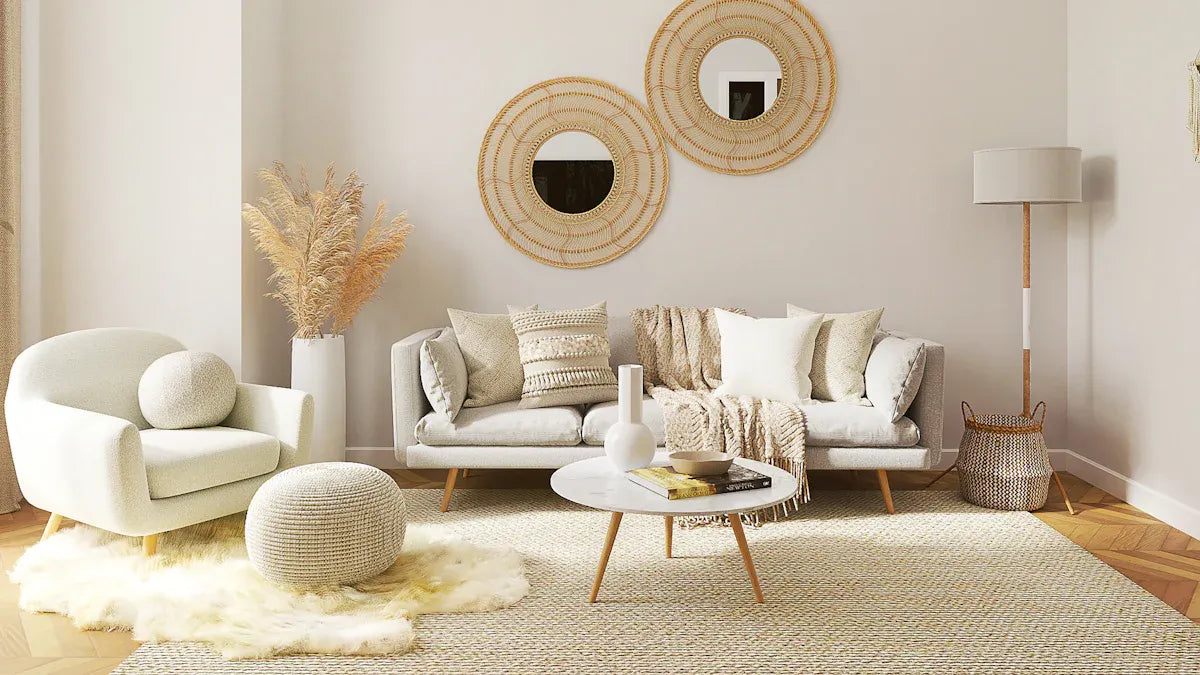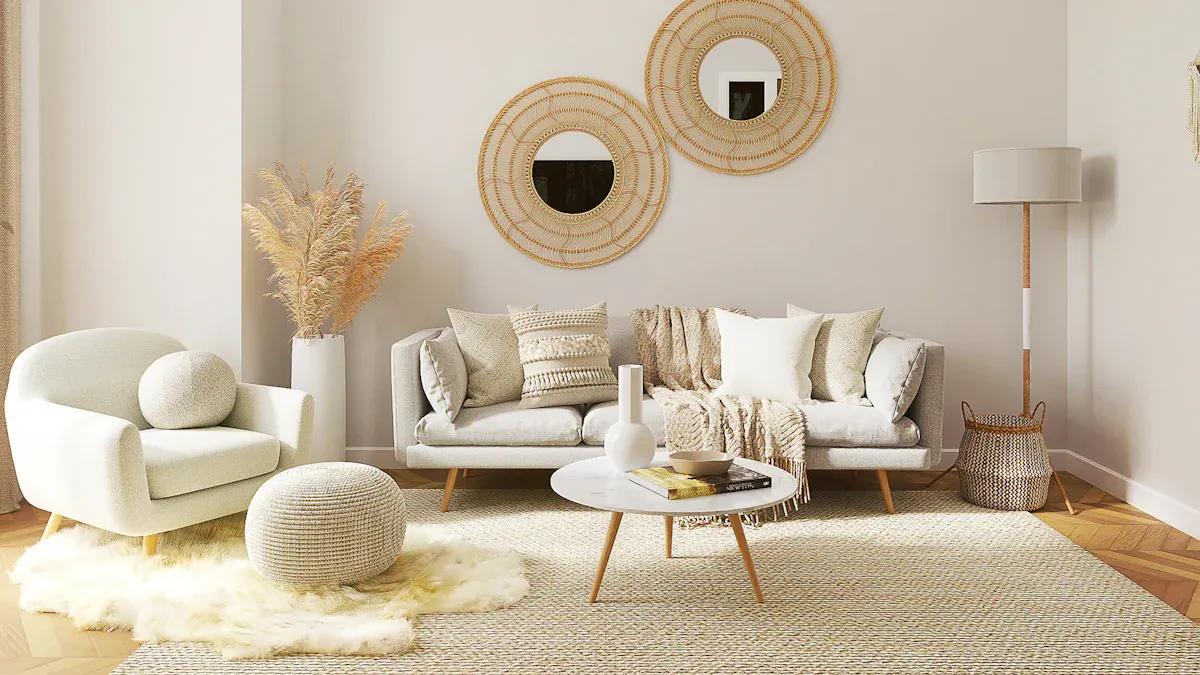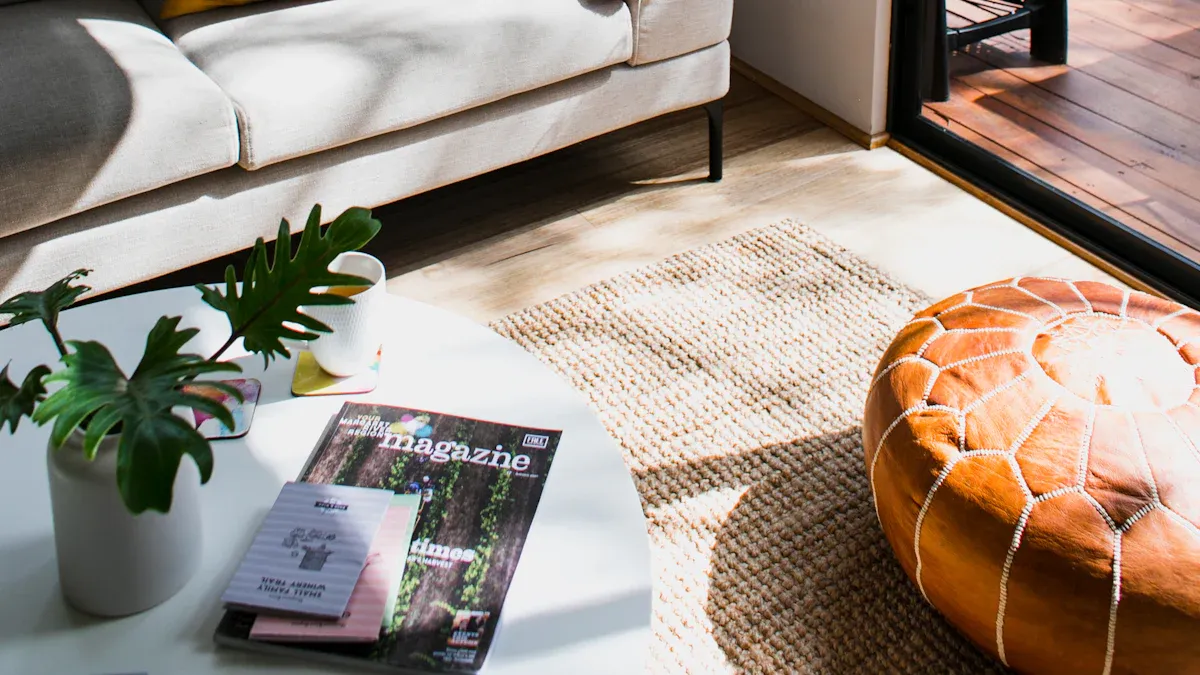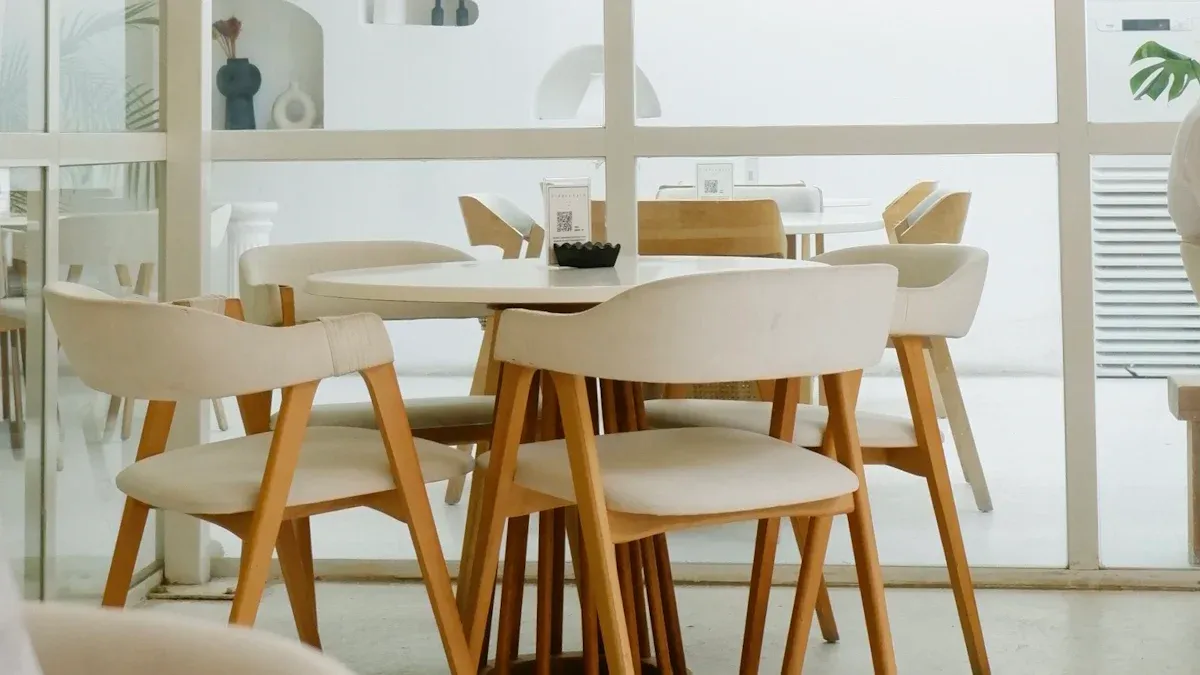
Small Room, Big Style: Expert Tips to Maximize Every Inch with Smart Design

Designing a small room comes with unique challenges. You often face limited floor space, making it essential to think creatively about functionality and style. Smart design can help you overcome these obstacles. For instance, multifunctional furniture like sofa beds or storage ottomans saves space while serving multiple purposes. Similarly, custom curtains not only enhance aesthetics but also transform your small home into a more functional space. Motorized curtains, for example, add convenience and privacy, especially in compact areas where manual adjustments may feel cumbersome. Thoughtful design choices like these can maximize every inch of your room.
Key Takeaways
Paint walls and use furniture in light colors. This makes small rooms feel open and bright.
Pick furniture that has more than one use, like sofa beds or storage ottomans. This saves space and adds function.
Clean up often to keep the room neat and roomy. A tidy space looks better and helps you feel good.
Place mirrors smartly to bounce light around. This makes the room look bigger.
Use curtains that match the wall color. This creates a smooth look and makes the room seem taller.
General Design Principles to Maximize Space
Light Colors for an Open and Airy Feel
Choosing the right color palette can transform your small room into a bright and inviting space. Light colors, such as whites, pastels, and soft neutrals, reflect more light, making the room feel larger and more open. You can paint your walls in these shades or incorporate them through furniture and decor. For example, a white sofa or pastel curtains can enhance the airy ambiance. Consistent colors across your room also eliminate visual breaks, creating a seamless and cohesive look. This simple design choice helps you maximize space while maintaining a stylish aesthetic.
Vertical Space: Shelving and Wall Decor
When floor space is limited, look up! Vertical space is often underutilized in small room design. Installing tall shelves or wall-mounted storage units can help you keep items off the floor, reducing clutter. Open shelving works well for displaying books, plants, or decorative items without overwhelming the room. You can also hang tall artwork or mirrors to draw the eye upward, giving the illusion of a higher ceiling. Remember to optimize your layout based on how you use the space. For instance, placing shelves near your desk or bed ensures easy access to essentials while keeping the room organized.
Multifunctional Furniture for Small Rooms
Multifunctional furniture is a game-changer for small space planning. Pieces like a coffee table with hidden storage or a sofa bed combine practicality with style. These adaptable designs allow you to use one item for multiple purposes, saving valuable space. For example, a storage ottoman can serve as a seat, a table, and a place to store blankets or books. This thoughtful approach to furniture selection enhances your daily life while keeping your small home clutter-free. By embracing multifunctional furniture, you can create a functional and visually appealing room that meets all your needs.
Decluttering for a Clean and Spacious Look
A clutter-free space can make your small room feel larger and more inviting. Decluttering not only improves the appearance of your room but also enhances your mental well-being. Research shows that clutter can increase stress and even strain relationships. By organizing your space, you create a more peaceful and productive environment.
Start by evaluating what you truly need. Items that no longer serve a purpose or bring you joy should be removed. You can donate, recycle, or sell these items to free up space. Focus on keeping only what adds value to your small home. This approach helps you limit clutter and maintain a clean, functional area.
To keep your small room organized, use smart storage solutions. Baskets, bins, and drawer organizers can help you store items neatly. Labeling these containers makes it easier to find what you need without creating a mess. Vertical storage, such as wall-mounted shelves, also keeps your floor space clear while providing ample room for your belongings.
Decluttering offers more than just a tidy room. It can improve your mood, reduce stress, and even boost productivity. Clean and organized spaces promote happiness and make your small home feel more spacious. By taking the time to declutter, you transform your room into a functional and stylish retreat.
Tip: Decluttering doesn’t have to be overwhelming. Tackle one area at a time, such as a drawer or a shelf, to make the process manageable.
Smart Design Tips for Maximizing Small Spaces

Mirrors to Create the Illusion of Space
Mirrors are one of the simplest yet most effective tools to make a small room look bigger. By reflecting light and creating depth, they can transform even the tiniest spaces into open and airy environments. Placing a large mirror opposite a window allows natural light to bounce around the room, brightening dark corners and enhancing the overall ambiance. You can also use mirrored furniture, such as a console table or cabinet, to add functionality while amplifying the sense of space.
Research highlights how mirrors influence our perception of space. They create a visual extension of the room, tricking the eye into seeing a larger area. For example, a full-length mirror on a closet door or a mirrored wall in a narrow hallway can make these areas feel more expansive. When thoughtfully positioned, mirrors not only enhance the aesthetic appeal but also contribute to a more functional and visually balanced design.
Tip: Use mirrors with decorative frames to add a touch of personality while maximizing their spatial benefits.
Furniture with Built-In Storage Solutions
In a small room, every piece of furniture should serve a purpose beyond its primary function. Furniture with built-in storage solutions offers a practical way to keep your space organized without sacrificing style. For instance, a bed with drawers underneath provides a hidden spot for storing clothes or linens, while a coffee table with a lift-top can double as a workspace and storage unit.
Smart furniture designs, such as ottomans with hidden compartments or wall-mounted desks, help you make the most of your limited space. These pieces reduce the need for additional storage units, freeing up valuable floor space and making the room feel less cluttered. Desks with built-in shelves or benches with storage compartments are excellent examples of multiuse storage options that combine functionality with elegance.
By incorporating furniture with built-in storage, you can create a thoughtfully designed space that meets your needs while maintaining a clean and spacious look. This approach not only enhances the room's functionality but also contributes to a more cohesive and stylish design.
Strategic Furniture Arrangement for Flow
The way you arrange furniture can significantly impact how a small room feels and functions. Strategic placement ensures a smooth flow of movement while maximizing the available space. Start by identifying the room's focal point, such as a window or a fireplace, and arrange your furniture around it. This creates a sense of balance and draws attention to the room's best features.
Avoid pushing all your furniture against the walls. Instead, leave a few inches of space between the furniture and the walls to create the illusion of a larger room. Use rugs to define different zones within the space, such as a seating area or a workspace. This technique works particularly well in open-plan layouts or studio apartments, where distinct zones help organize the room.
A table summarizing strategic design elements can help you visualize their benefits:
Strategic Element |
Benefits |
|---|---|
Resource Allocation |
Maximizes use of available materials and space |
Flexible Design |
Adapts to different functions and needs |
Smart Technology Integration |
Enhances productivity through automation |
Zone Creation |
Defines areas for specific activities, aiding organization |
By arranging your furniture thoughtfully, you can make a small room look bigger and more functional. This approach not only improves the room's flow but also enhances its overall aesthetic appeal.
Note: Keep walkways clear to ensure easy movement and prevent the room from feeling cramped.
Lighting to Brighten and Enlarge the Room
Lighting plays a crucial role in making a small room feel larger and more inviting. The right lighting techniques can transform your space, enhance its functionality, and even make your room look wider. By focusing on both natural light and artificial lighting, you can create a bright and spacious environment.
Maximize Natural Light
Natural light is your best friend when it comes to opening up a small room. It not only brightens the space but also creates a sense of depth and warmth. Start by keeping your windows unobstructed. Avoid heavy or dark curtains that block sunlight. Instead, opt for sheer or light-colored custom curtains that allow natural light to flow freely into the room.
Mirrors can also amplify natural light. Place a mirror opposite a window to reflect sunlight throughout the room. This simple trick enhances brightness and makes the space feel larger. If privacy is a concern, consider using frosted glass or light-filtering window treatments to maintain a balance between light and seclusion.
Tip: Clean your windows regularly to ensure maximum sunlight enters your room. Even a thin layer of dust can reduce the amount of light coming in.
Layer Artificial Lighting
When natural light is limited, artificial lighting becomes essential. A layered lighting approach works best for small spaces. Combine ambient, task, and accent lighting to create a well-lit and visually appealing room.
Ambient Lighting: This is your primary source of light. Ceiling fixtures, such as flush mounts or pendant lights, work well in small rooms. Choose fixtures that distribute light evenly across the space.
Task Lighting: Use task lighting for specific activities like reading or working. Desk lamps, under-cabinet lights, or wall-mounted sconces provide focused illumination without taking up valuable floor space.
Accent Lighting: Highlight decorative elements with accent lighting. LED strips under shelves or spotlights on artwork can add depth and character to your room.
Smart lighting solutions, such as dimmable bulbs or color-changing LEDs, allow you to adjust the brightness and mood of your room. These options give you greater control over your space and enhance its versatility.
Choose Light Fixtures Wisely
The type of light fixtures you choose can impact how spacious your room feels. In small rooms, avoid bulky or oversized fixtures that dominate the space. Instead, go for sleek and minimalist designs that blend seamlessly with your decor.
Wall-mounted lights or recessed lighting are excellent choices for small spaces. They save floor and table space while providing ample illumination. Pendant lights with transparent or open designs can also add a touch of elegance without overwhelming the room.
Note: Use warm white bulbs for a cozy ambiance or cool white bulbs for a brighter, more modern look.
Use Light Colors to Enhance Brightness
Light-colored walls, ceilings, and furniture reflect light better than dark colors. This reflection amplifies both natural and artificial light, making your room feel brighter and more open. Pairing light-colored decor with strategic lighting creates a harmonious and spacious atmosphere.
For example, a white or pastel lampshade can diffuse light softly across the room, enhancing its overall brightness. Similarly, light-colored curtains can complement your lighting setup while maintaining a cohesive design.
By combining these lighting strategies, you can brighten your small room and make it feel larger and more welcoming. Thoughtful lighting not only improves the functionality of your space but also elevates its style and comfort.
Custom Curtains: A Game-Changer for Small Rooms
Custom curtains can completely transform the look and feel of a small room. They not only enhance the style of your space but also serve as a practical tool to make your room appear larger and more inviting. By carefully selecting and positioning your curtains, you can create the illusion of height, depth, and openness. Let’s explore how custom-made curtains can elevate your small room design.
Hanging Curtains High to Add Height
The way you hang your curtains can significantly impact the perception of your room’s height. When you hang curtains closer to the ceiling, you draw the eye upward, making the walls appear taller. This simple trick can prevent your small room from feeling cramped or visually smaller.
Place the curtain rod about two-thirds of the distance between the window frame and the ceiling. This placement elongates the walls and creates vertical lines that enhance the perception of height.
Use long curtains that extend from the ceiling to the floor. This approach adds elegance while maximizing the visual height of your space.
Consider mounting the curtain track near the ceiling for a seamless and modern look. This technique works especially well in rooms with low ceilings, as it creates a sense of openness.
Tip: Extend the curtain rod beyond the width of the window to make the window appear larger. This trick adds depth and makes your small room feel more spacious.
Light Fabrics for a Spacious Ambiance
The fabric you choose for your curtains plays a crucial role in how your room feels. Light and airy fabrics can make your small room appear more open and inviting. Heavy or dark drapes, on the other hand, can weigh down the space and make it feel smaller.
Opt for sheer or semi-sheer fabrics to allow natural light to flow through the room. This not only brightens the space but also creates a soft and welcoming ambiance.
Choose light-colored curtains, such as whites, pastels, or soft neutrals. These colors reflect light and enhance the airy feel of your room.
Avoid overly thick or textured fabrics in small spaces. Instead, go for materials like linen or cotton blends that balance functionality with style.
By selecting the right fabric, you can maintain a spacious and cohesive look while adding a touch of elegance to your room.
Note: Light fabrics are ideal for layering. Pair them with blackout drapes for privacy and light control without compromising the room’s openness.
Layered Curtains for Style and Functionality
Layering curtains is a smart way to combine style with practicality. This technique allows you to customize the look and functionality of your window treatments, making them versatile for any time of day or occasion.
Use a combination of sheer curtains and heavier drapes. Sheer curtains let in natural light during the day, while heavier drapes provide privacy and block out light when needed.
Experiment with different textures and colors to add depth and character to your room. For example, pair neutral sheers with bold-colored drapes to create a striking contrast.
Extend layered curtains across an entire wall to give the impression of a larger window. This approach adds depth and makes your small room feel more expansive.
Layering curtains not only enhances the aesthetic appeal of your space but also improves its functionality. You can easily adjust the layers to control light, privacy, and temperature, making your room more comfortable and stylish.
Tip: Wall-to-wall curtains behind a headboard can create a cozy and balanced look in a small bedroom while maintaining privacy.
Custom curtains are more than just window treatments; they are a powerful design tool. By hanging them high, choosing light fabrics, and layering them effectively, you can transform your small room into a stylish and functional space.
Matching Curtains to Walls for Seamlessness
Matching your curtains to your walls can create a seamless and harmonious look in any small room. This design technique eliminates visual breaks, making the space feel larger and more cohesive. When the colors and textures of your curtains blend with your walls, the room appears less cluttered and more unified. This approach works especially well in compact spaces where every design choice matters.
Why Matching Curtains to Walls Works
When curtains and walls share similar tones or textures, they create a monochromatic effect. This effect minimizes distractions and allows the eye to flow naturally across the room. For example, light-colored curtains paired with pastel walls can make a small room feel open and airy. On the other hand, darker tones like deep brown or charcoal can add warmth and depth without overwhelming the space.
Research supports the importance of matching curtain colors and textures to walls. Different combinations can evoke specific moods and enhance the overall design. The table below highlights how certain curtain colors influence the style and ambiance of a room:
Curtain Color |
Effect on Design |
Key Points |
|---|---|---|
Velvet Violet |
Adds luxury and depth, enhancing the room's character. |
Complements ambiance; creates an aesthetically pleasing environment. |
Tangerine |
Creates monochromatic harmony and adds depth. |
Offers warmth; varying shades prevent flatness; can be striking with thoughtful execution. |
Silver |
Introduces sophistication and balances warmth of orange. |
Cooling contrast; light-reflecting materials enhance modern aesthetics. |
Dark Brown |
Grounds vibrancy of orange, creating a warm and inviting ambiance. |
Provides pleasing contrast; enhances depth; suitable for various design themes. |
Tips for Matching Curtains to Walls
Choose Similar Tones: Select curtains in the same color family as your walls. For instance, if your walls are light gray, opt for curtains in a slightly darker or lighter shade of gray. This subtle variation adds depth while maintaining harmony.
Experiment with Textures: If you prefer a more dynamic look, match the color of your curtains to your walls but vary the texture. For example, pair smooth satin curtains with matte-painted walls to create visual interest without disrupting the seamless effect.
Use Patterns Sparingly: In small rooms, bold patterns can feel overwhelming. If you want to incorporate patterns, choose subtle designs that echo the wall color. Stripes or geometric prints in muted tones can add character without overpowering the space.
Extend the Curtains Across the Wall: For a truly seamless look, consider extending your curtains across an entire wall. This technique works well in rooms with large windows or sliding doors. It creates the illusion of a larger window and adds depth to the room.
Tip: If you're unsure about matching colors, start with neutral tones like beige, white, or gray. These colors are versatile and work well with most design styles.
Achieving Seamlessness with Freshine Custom Curtains
Freshine Custom Curtains make it easy to achieve a seamless look in your small room. With a wide range of colors and fabrics, you can find the perfect match for your walls. Whether you prefer the airy elegance of sheer curtains or the luxurious feel of velvet, Freshine offers options that blend style with functionality. Each curtain is hand-tailored to ensure a flawless fit, helping you create a cohesive and polished design.
By matching your curtains to your walls, you can transform your small room into a stylish and inviting space. This simple yet effective design choice enhances the room's flow and makes it feel more spacious. With the right curtains, you can achieve a seamless look that reflects your unique taste.
Small Bedroom Ideas with Custom Curtains

Creating a Cozy Yet Functional Bedroom
Transforming a small bedroom into a cozy yet functional retreat requires thoughtful design choices. Curtains play a pivotal role in achieving this balance. They can define areas for sleeping, dressing, or working without the need for bulky furniture or permanent walls. For example, a curtain can separate a workspace from your sleeping area, maintaining privacy while keeping the room open.
Soft colors and light fabrics enhance the cozy atmosphere. A full wall of curtains behind the bed adds softness and creates an inviting focal point. This approach is both stylish and affordable, making it ideal for small and stylish bedroom designs. Pairing curtains with multifunctional furniture, like a bed with built-in storage, maximizes space while maintaining a warm and welcoming vibe.
Tip: Use custom curtains to match the unique dimensions of your room, especially if you have slanted ceilings or nooks. This ensures a perfect fit and a polished look.
Using Sheer Curtains for Natural Light
Sheer curtains are a fantastic choice for small bedrooms. They allow natural light to flow freely, making the room feel brighter and more spacious. Unlike heavy drapes, sheer fabrics maintain an open feel while providing privacy. This makes them perfect for creating a light and airy ambiance in compact spaces.
To enhance the effect, pair sheer curtains with light-colored walls and minimal decor. This combination reflects sunlight, amplifying the brightness of the room. You can also layer sheer curtains with blackout drapes for added functionality. During the day, enjoy the natural light; at night, close the blackout layer for privacy and better sleep.
Note: Regularly clean your sheer curtains to keep them looking fresh and to maximize the light they let in.
Extending Curtain Tracks for Larger Windows
In small bedrooms, extending curtain tracks beyond the window frame can create the illusion of larger windows. This simple trick draws the eye outward, making the room feel more expansive. By covering the wall space around the window, you also add depth and elegance to the design.
Choose custom curtains that complement your bedroom’s color palette for a seamless look. For instance, light-colored curtains paired with extended tracks can make the room appear taller and more open. This technique works especially well in rooms with low ceilings or narrow windows.
Tip: Use ceiling-mounted tracks for a sleek and modern finish. This approach elongates the walls and enhances the overall aesthetic of your small bedroom.
Practical Examples of Maximizing Small Spaces
A Studio Apartment with Smart Storage
Living large when space is tight requires creative solutions, especially in a studio apartment. Smart storage options can help you maximize every inch while maintaining a stylish and functional design. Start by incorporating furniture that doubles as storage. A bed with built-in drawers or a sofa with hidden compartments can keep your belongings organized without taking up extra room. Wall-mounted shelves are another excellent choice. They free up floor space and provide a place to display books, plants, or decor.
To make the most of your studio, use vertical storage solutions. Tall cabinets or shelving units draw the eye upward, creating the illusion of a larger room. Pair these with light-colored curtains to enhance the airy feel of the space. Curtains can also serve as dividers, separating your sleeping area from your living space without the need for bulky partitions. This approach keeps the room open and functional.
Tip: Use labeled bins or baskets on shelves to keep items tidy and easy to find.
A Small Bedroom with Vertical Design and Custom Curtains
A small bedroom can feel spacious and elegant with the right vertical design elements and custom curtains. Placing a bed in front of a window maximizes floor space while creating a serene focal point. Floor-length curtains add height and elegance, making the room feel taller. Vertical blinds also enhance light control and complement the overall aesthetic.
Custom curtains tailored to your bedroom’s dimensions ensure a perfect fit, even for unique layouts like slanted ceilings. Light fabrics and soft colors amplify natural light, creating an open and inviting atmosphere. Layering curtains with blackout options provides privacy and flexibility, making your bedroom both functional and stylish.
Note: Extend curtain tracks beyond the window frame to make the room appear larger.
A Compact Living Room with Multifunctional Furniture
In a compact living room, multifunctional furniture is essential for combining style and practicality. A coffee table with a lift-top can double as a workspace, while a storage ottoman offers seating and hidden storage. These pieces reduce clutter and enhance the room’s functionality.
The growing popularity of multifunctional furniture highlights its impact on small spaces. The global market for these designs was valued at $12.8 billion in 2023 and is projected to reach $21.7 billion by 2032. Sleek, modern designs not only save space but also elevate the aesthetics of compact living areas.
Strategic furniture placement further enhances the room’s flow. Avoid overcrowding by leaving clear pathways and using rugs to define zones. Pairing multifunctional furniture with light-colored curtains creates a cohesive and spacious look.
Tip: Choose furniture with clean lines and neutral tones to maintain a minimalist and open feel.
Smart design transforms a small room into a functional and stylish space. By using techniques like strategic furniture placement, layered lighting, and custom curtains, you can maximize every inch of your home. Curtains, in particular, play a vital role in enhancing both the aesthetics and functionality of your bedroom. They create the illusion of height, improve light control, and add a touch of elegance.
Start applying these tips today to elevate your small bedroom. For tailored solutions, explore Freshine Custom Curtains. Their high-quality, eco-friendly options ensure a perfect fit for your unique space.
FAQ
What are the best colors for a small room?
Light colors like white, pastel shades, and soft neutrals work best. They reflect light, making the space feel open and airy. Avoid dark or bold colors, as they can make the room feel smaller and more enclosed.
How can I make a small room look taller?
Hang curtains close to the ceiling and use vertical design elements like tall shelves or artwork. These tricks draw the eye upward, creating the illusion of height. Avoid low-hanging decor or furniture that emphasizes horizontal lines.
Are custom curtains worth it for small spaces?
Yes, custom curtains fit your windows perfectly and enhance the room's style. They can create the illusion of height, improve light control, and add elegance. Tailored options ensure you maximize both functionality and aesthetics in your small room.
What type of furniture works best in small rooms?
Multifunctional furniture is ideal. Look for pieces like beds with built-in storage, foldable desks, or ottomans with hidden compartments. These designs save space while offering practical solutions for storage and daily use.
How do mirrors help in small rooms?
Mirrors reflect light and create depth, making a small room feel larger. Place a mirror opposite a window to amplify natural light or use mirrored furniture to enhance the sense of space without adding clutter.










